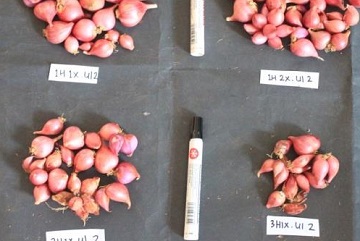IPB Researchers Created the Best Methods on Red Onion Cultivation Using Spray Hose Irrigation

Rahmi Fauzi, student of Agronomy and Horticulture Study Program of Institut Pertanian Bogor (IPB Bogor Agricultural University), together with Prof. Dr. Anas Dinurrohman Susila and Dr. Eko Sulistyono, implemented the research program on "Budidaya Bawang Merah (Allium cepa var. aggregatum) pada Lahan Kering Menggunakan Irigasi Spray hose pada Berbagai Volume Irigasi dan Frekuensi Irigasi = Red Onion Cultivation (Allium cepa var aggregatum) on Dry Land Using Spray Hose Irrigation on Various Irrigation Volumes and Frequencies". This study aims to analyse the water requirement on shallot plants utilizing spray hose irrigation system.
Onion is one of the most important national commercial vegetable commodities besides red peppers and potatoes. Onion is a strategic commodity because it is taken and consumed by most of Indonesian people in everyday life, thus affecting macro economy and inflation rate. The Indonesian market for onions for human consumption is growing. Onion cultivation in Indonesia generally uses a surface irrigation system, which requires a lot of irrigation water. Irrigation scheduling is directly related to profitable onion production and sustainable agricultural practices. Outside of Java, the centre of onion production is West Nusa Tenggara (NTB), West Sumatra and South Sulawesi, including dry land.
Onions are widely grown across a range of climates but thrive best when temperatures are cool during early development and then warmer and sunny during maturity. Onion cultivation is generally done on dry land and requires irrigation. Generally, onion plants do not need consistent watering if mulch is used. Utilization of dry land in Indonesia is relatively small, while the potential of land that is considered marginal is large enough for agricultural development. Planting on dry land requires adequate watering. Water is often a limiting factor for plant growth, especially in dry and semi-arid areas, but even in some humid areas.
Irrigation is a crucial factor in agricultural activities especially for dry land. One of the most cost-effective irrigation systems in water use is pressurized irrigation. Innovative irrigation practices can enhance water efficiency, gaining an economic advantage while also reducing environmental burdens. Pressurized irrigation has an advantage in water use efficiency so it is suitable to be applied on dry land. Spray irrigation (spray) is one of the pressurized irrigation systems that provide water through an extensive pipeline usually with a small diameter to the ground near the plant. The spray irrigation system has advantages in water use efficiency making it suitable for dry land use.
This research was carried out in experimental garden of Teaching Farm and Postharvest Laboratory of Agronomy and Horticulture Department of IPB on October 2014 until April 2015. The research revealed that Onion plants can grow normally with water requirement of 81.17 percent. The provision of water with spray hose irrigation system also gives a better effect than conventional which uses watering pots (gembor). On the three-day irrigation water supply at one time will have an impact on the availability of little water for the plant. The best frequency for irrigation frequency based on harvest weight per plot is twice daily. It is expected that recommendations resulted from the present research will be utilized by the communities, especially onion farmers to calculate the minimum water requirement and the best irrigation frequency with spray hose system on shallot cultivation. (Wied)



